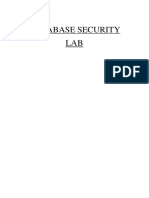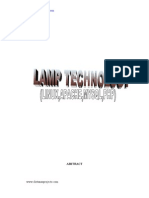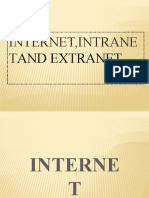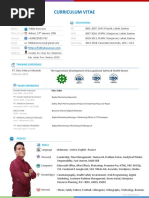Web Browser
Uploaded by
vanshikarockWeb Browser
Uploaded by
vanshikarockBROWSER DEFINED
Back to the definition of a browser…according to the several
dictionaries and online sources, a web browser is defined as;
“…a program used to view HTML documents.”
“A web browser is a software application for retrieving, presenting,
and traversing information resources on the World Wide Web”
“Software used to display the World Wide Web and often the Internet
in general. Examples include Internet Explorer, Mozilla Firefox, Opera,
Safari and Google Chrome”
“An easy-to-use software tool for accessing the World Wide Web and
the Internet.”
In other words a browser is an application or program installed on your
computer that allows you to view web pages that reside on the World
Wide Web/internet.
WEB BROWSER
A web browser is a software application for retrieving, presenting, and
traversing information resources on the World Wide Web.
An information resource is identified by a Uniform Resource Identifier (URI)
and may be a web page, image, video, or other piece of content.
Hyperlinks present in resources enable users to easily navigate their
browsers to related resources.
Although browsers are primarily intended to access the World Wide Web,
they can also be used to access information provided by web-
Servers in private networks or files in file systems.
The major web browsers are Windows Internet Explorer, Mozilla
Firefox, Apple Safari, Google Chrome, and Opera.
FUNCTIONS
The primary purpose of a web browser is to bring
information resources to the user.
This process begins when the user inputs a Uniform
Resource Identifier (URI)
for example http://en.wikipedia.org/ into the
browser.
• The prefix of the URI determines how the URI will be
interpreted.
Common kinds of
Prefixes
http: identifies a resource to be retrieved over
the Hypertext Transfer Protocol (HTTP).
https: for HTTPS,
ftp: for the File Transfer Protocol, and
file: for local files.
Prefixes that the web browser cannot directly handle are
often handed off to another application entirely.
mailto: URIs are usually passed to the user's default e-mail
application, and
news: URIs are passed to the user's default newsgroup reader.
How it Works?
Once the resource has been retrieved the web browser
will display it.
HTML is passed to the browser's layout engine to be
transformed from markup to an interactive document.
Web browsers can generally display any kind of content
that can be part of a web page.
Most browsers can display images, audio, video,
and XML files, and often have plug-ins to
support Flash applications and Java applets.
For file of an unsupported type or a file that is set up to
be downloaded rather than displayed, the browser
prompts the user to save the file to disk.
FUNCTIONS CONTD…
Information resources may contain hyperlinks to
other information resources.
Each link contains the URI of a resource to go to.
When a link is clicked, the browser navigates to the
resource indicated by the link's target URI, and the
process of bringing content to the user begins
again.
FEATURES OF WEB
BROWSERS
Minimal, text-based user interfaces with bare-bones
support for HTML
Rich user interfaces supporting a wide variety of
file formats and protocols.
Browsers which include additional components to
support e-mail, Usenet news, and Internet Relay
Chat (IRC), are sometimes referred to as "Internet
suites" rather than merely "web browsers”.
contd..
All major web browsers allow the user to open multiple
information resources at the same time, either in different
browser windows or in different tabs of the same window.
Major browsers also include pop-up blockers to prevent
unwanted windows from "popping up" without the user's
consent.
Most web browsers can display a list of web pages that
the user has bookmarked so that the user can quickly
return to them.
Bookmarks are also called "Favorites" in Internet Explorer.
Features of Web Browsers
Contd…
All major web browsers have some form of built-
in web feed aggregator.
In Mozilla Firefox, web feeds are formatted as "live
bookmarks" and behave like a folder of bookmarks
corresponding to recent entries in the feed.
In Opera, a more traditional feed reader is included
which stores and displays the contents of the feed.
Most browsers can be extended via plug-ins,
downloadable components that provide additional
features.
Some User Interface
elements
Back and forward buttons to go back to the previous resource and forward
again.
A refresh or reload button to reload the current resource.
A stop button to cancel loading the resource. In some browsers, the stop
button is often merged with the reload button.
A home button to return to the user's home page
An address bar to input the Uniform Resource Identifier (URI) of the desired
resource and display it.
A search bar to input terms into a search engine
A status bar to display progress in loading the resource and also the URI of
links when the cursor hovers over them, and page zooming capability.
Major browsers also possess incremental find features to search within a
web page.
Privacy and security
Most browsers support HTTP Secure and offer quick
and easy ways to delete the web cache, cookies,
and browsing history.
Standards support
Early web browsers supported only a very simple version
of HTML.
The rapid development of proprietary web browsers led
to the development of non-standard dialects of HTML,
leading to problems with interoperability.
Modern web browsers support a combination of
standards-based and de facto HTML and XHTML, which
What is a search engine?
A search engine unlike a browser does not
reside as an application on your computer.
The search engine resides in the cloud (the
internet).
It is an index of ALL the websites in existence,
in other words it keeps track of all the web
pages ever published.
This index allows search engines to provide
you with results to your queries or searches.
WEB SEARCH ENGINES
A web search engine is a tool designed to search for
information on the World Wide Web.
The search results are usually presented in a list and are
commonly called hits.
The information may consist of web pages, images,
information and other types of files.
Some search engines also mine data available
in databases or open directories.
Unlike Web directories, which are maintained by human
editors, search engines operate algorithmically or are a
mixture of algorithmic and human input.
Engines
A search engine operates, in the following order:
Web crawling
Indexing
Searching
Web search engines work by storing information
about many web pages, which they retrieve from
the WWW itself.
How it works?
These pages are retrieved by a Web crawler.
Web crawlers are sometimes also known as a spider
- an automated Web browser which follows every link
it sees.
The contents of each page are then analyzed to
determine how it should be indexed
for example, words are extracted from the titles,
headings, or special fields called meta tags.
Data about web pages are stored in an index database
for use in later queries.
Engines
Google, store all or part of the source page (referred to as
a cache) as well as information about the web pages.
AltaVista, store every word of every page they find.
This cached page always holds the actual search text since
it is the one that was actually indexed, so it can be very
useful when the content of the current page has been
updated and the search terms are no longer in it.
Increased search relevance makes these cached pages very
useful, even beyond the fact that they may contain data that
may no longer be available elsewhere.
What exactly happens?
When a user enters a query into a search engine
(typically by using key words), the engine examines
its index and provides a listing of best-matching web
pages according to its criteria, usually with a short
summary containing the document's title and sometimes
parts of the text.
Most search engines support the use of the Boolean
operators AND, OR and NOT to further specify the search
query.
Some search engines provide an advanced feature
called proximity search which allows users to define the
distance between keywords.
Does it provide irrelevant
information too?
The usefulness of a search engine depends on
the relevance of the result set it gives back.
While there may be millions of web pages that include a
particular word or phrase, some pages may be more
relevant, popular, or authoritative than others.
Most search engines employ methods to rank the results
to provide the "best" results first.
How a search engine decides which pages are the best
matches, and what order the results should be shown in,
varies widely from one engine to another.
The methods also change over time as Internet usage
changes and new techniques evolve.
Survival of Search Engines
Most Web search engines are commercial ventures
supported by advertising revenue and, as a result, some
employ the practice of allowing advertisers to pay money
to have their listings ranked higher in search results.
Those search engines which do not accept money for their
search engine results make money by running search
related ads alongside the regular search engine results.
The search engines make money every time someone
clicks on one of these ads.
A browser allows you to reach a search engine, submit a
query, and display the results of that query in the browser
window.
23
24
You might also like
- Secure Web Application Development Lifecycle Practitioner (SWADLP) CertificationNo ratings yetSecure Web Application Development Lifecycle Practitioner (SWADLP) Certification10 pages
- Software Engineering B.Tech IT/II Sem-IINo ratings yetSoftware Engineering B.Tech IT/II Sem-II44 pages
- Par T A - Multiple Choice Questions: Total 10 Mar KsNo ratings yetPar T A - Multiple Choice Questions: Total 10 Mar Ks15 pages
- Types of Web Browsers Google Chrome Microsoft Internet Explorer Mozilla Firefox Opera Apple SafariNo ratings yetTypes of Web Browsers Google Chrome Microsoft Internet Explorer Mozilla Firefox Opera Apple Safari10 pages
- 1 Abstract: Both Host Names Are IP Addresses and Their Host Name Strings Match Exactly or100% (1)1 Abstract: Both Host Names Are IP Addresses and Their Host Name Strings Match Exactly or20 pages
- 3-Tier Architecture: Praveen Anuranjan RohitNo ratings yet3-Tier Architecture: Praveen Anuranjan Rohit19 pages
- Lab No:01 Title:: Introduction To Database and Tool UsageNo ratings yetLab No:01 Title:: Introduction To Database and Tool Usage5 pages
- Department of Mathematics: Lab Engineer: Sara MehmoodNo ratings yetDepartment of Mathematics: Lab Engineer: Sara Mehmood7 pages
- A Project On Various Browsers and Free ToolsNo ratings yetA Project On Various Browsers and Free Tools18 pages
- OWASP Amass - A Solid Information Gathering ToolNo ratings yetOWASP Amass - A Solid Information Gathering Tool44 pages
- Database Security and Auditing: Chapter 5No ratings yetDatabase Security and Auditing: Chapter 545 pages
- Reflected Cross Site Scripting (XSS) AttacksNo ratings yetReflected Cross Site Scripting (XSS) Attacks4 pages
- Top 10 Web Application Development Frameworks 2016No ratings yetTop 10 Web Application Development Frameworks 201625 pages
- What Is Metasploit Framework and How To Use MetasploitNo ratings yetWhat Is Metasploit Framework and How To Use Metasploit17 pages
- Oracle Database Security: Presented by Wilson CriderNo ratings yetOracle Database Security: Presented by Wilson Crider94 pages
- Best Practices of Web Application Security by Samvel GevorgyanNo ratings yetBest Practices of Web Application Security by Samvel Gevorgyan88 pages
- Selenium BasicAutomatedTesting TutorialNo ratings yetSelenium BasicAutomatedTesting Tutorial10 pages
- Lab 23 - IA1603 - TRẦN DOÃN ANH - SE150630No ratings yetLab 23 - IA1603 - TRẦN DOÃN ANH - SE1506305 pages
- Evaluationof Web Vulnerability Scanners Basedon OWASPBenchmarkNo ratings yetEvaluationof Web Vulnerability Scanners Basedon OWASPBenchmark7 pages
- Comptia Security+ Certification Support Skills: 1.2 Threats and AttacksNo ratings yetComptia Security+ Certification Support Skills: 1.2 Threats and Attacks19 pages
- PHP Security Crash Course - 1 - Introduction100% (1)PHP Security Crash Course - 1 - Introduction13 pages
- ColdFusion Interview Questions, Answers, and Explanations: ColdFusion Certification ReviewFrom EverandColdFusion Interview Questions, Answers, and Explanations: ColdFusion Certification ReviewNo ratings yet
- Tle6 - q2 - Mod5 - Posting and Sharing Materials On Blogs in A Safe and Responsible MannerNo ratings yetTle6 - q2 - Mod5 - Posting and Sharing Materials On Blogs in A Safe and Responsible Manner28 pages
- 4.pdf VPN Request Form Third Party Agreement Form: South Dakota State University Policy and Procedure ManualNo ratings yet4.pdf VPN Request Form Third Party Agreement Form: South Dakota State University Policy and Procedure Manual2 pages
- Resume 111708004 Sushant For Sushant AgawaneNo ratings yetResume 111708004 Sushant For Sushant Agawane1 page
- Essay On Positive and Negative Effects of Social MediaNo ratings yetEssay On Positive and Negative Effects of Social Media4 pages
- Information Technology 802 Class 12 Lesson 2 Operating WebNo ratings yetInformation Technology 802 Class 12 Lesson 2 Operating Web30 pages
- Assignment On FullStack Web Developer-BluestacksNo ratings yetAssignment On FullStack Web Developer-Bluestacks2 pages
- FortiSIEM-6.1.2-External Systems Configuration GuideNo ratings yetFortiSIEM-6.1.2-External Systems Configuration Guide727 pages
- Secure Web Application Development Lifecycle Practitioner (SWADLP) CertificationSecure Web Application Development Lifecycle Practitioner (SWADLP) Certification
- Par T A - Multiple Choice Questions: Total 10 Mar KsPar T A - Multiple Choice Questions: Total 10 Mar Ks
- Types of Web Browsers Google Chrome Microsoft Internet Explorer Mozilla Firefox Opera Apple SafariTypes of Web Browsers Google Chrome Microsoft Internet Explorer Mozilla Firefox Opera Apple Safari
- 1 Abstract: Both Host Names Are IP Addresses and Their Host Name Strings Match Exactly or1 Abstract: Both Host Names Are IP Addresses and Their Host Name Strings Match Exactly or
- Lab No:01 Title:: Introduction To Database and Tool UsageLab No:01 Title:: Introduction To Database and Tool Usage
- Department of Mathematics: Lab Engineer: Sara MehmoodDepartment of Mathematics: Lab Engineer: Sara Mehmood
- Top 10 Web Application Development Frameworks 2016Top 10 Web Application Development Frameworks 2016
- What Is Metasploit Framework and How To Use MetasploitWhat Is Metasploit Framework and How To Use Metasploit
- Oracle Database Security: Presented by Wilson CriderOracle Database Security: Presented by Wilson Crider
- Best Practices of Web Application Security by Samvel GevorgyanBest Practices of Web Application Security by Samvel Gevorgyan
- Evaluationof Web Vulnerability Scanners Basedon OWASPBenchmarkEvaluationof Web Vulnerability Scanners Basedon OWASPBenchmark
- Comptia Security+ Certification Support Skills: 1.2 Threats and AttacksComptia Security+ Certification Support Skills: 1.2 Threats and Attacks
- ColdFusion Interview Questions, Answers, and Explanations: ColdFusion Certification ReviewFrom EverandColdFusion Interview Questions, Answers, and Explanations: ColdFusion Certification Review
- Tle6 - q2 - Mod5 - Posting and Sharing Materials On Blogs in A Safe and Responsible MannerTle6 - q2 - Mod5 - Posting and Sharing Materials On Blogs in A Safe and Responsible Manner
- 4.pdf VPN Request Form Third Party Agreement Form: South Dakota State University Policy and Procedure Manual4.pdf VPN Request Form Third Party Agreement Form: South Dakota State University Policy and Procedure Manual
- Essay On Positive and Negative Effects of Social MediaEssay On Positive and Negative Effects of Social Media
- Information Technology 802 Class 12 Lesson 2 Operating WebInformation Technology 802 Class 12 Lesson 2 Operating Web
- FortiSIEM-6.1.2-External Systems Configuration GuideFortiSIEM-6.1.2-External Systems Configuration Guide

























































































